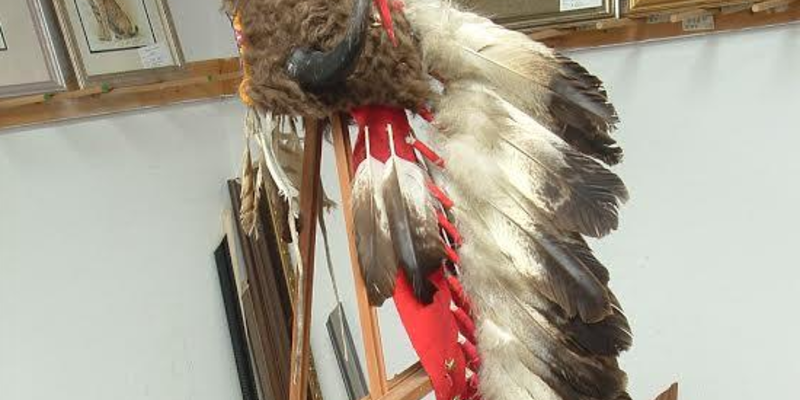
About 15 years ago I walked into an art gallery in the quaint town of Germanton, NC. As the heavy door closed behind me so did the bright October light outside.
When my eyes adjusted to the soft light and beauty, I felt I’d slid down an exceptionally nice rabbit hole.
Bottles of wine laden with award winning medals beckoned me to their counter but it was only 10 o’clock so I sashayed through the aisles of local and world renowned art while listening to beautiful Celtic & Indian music.

David Simpson peeked out of the back with a Cheshire cat grin and welcomed me to his Wonderland. It was the first of many visits to Germanton Art Gallery. I would pop in periodically over the years to check out the latest art, buy a bottle of wine, or just talk. We have a similar interest - his Lumbee Indian heritage, my Cherokee and — a mutual love of history.
David and Judy Simpson own Germanton Art Gallery, established in 1981. They are lovers and creators of art, gentle activists of the land who advocate preserving the earth’s resources and — they grow some mighty fine grapes.
We moved back to Charleston 6 years ago, but I still keep up with David via Facebook and visit when we are in the area. I love to share his jewel in the hills and took a friend with me on a return trip 2 years ago. David was piddling around and getting ready for an art show, possibly their annual Plein Air exhibit.
Per usual as we browsed David filled me in on the dispositions of various artists’.
While doing so his eyes lit up and he said, “You need to come look at this!” He led us to his frame shop in the back and stopped. “It’s a Lakota/Sioux medicine man’s war bonnet,” he told me pointing to a full Indian headdress cascading off of a frame. He smiled when he saw my mouth drop. I was totally awestruck. There was a bison skull cap, eagle feathers affixed to a French fur trader blanket, U.S. Calvary buttons were sewn onto the blanket and tied to the right horn, intricate bead work was across the front band and lastly, Porcupine quills spaced between the two horns which means it was worn in battle.

“Where in the world did you get this?” I asked him.
“I frequently displayed paintings of my friend and painter Gordon Phillips. Gordon was a painter of all things American west and later in life - depictions of Civil War life. Gordon actually lived with the Sioux Indians on their reservation in South Dakota for a time, he painted tribal members and depictions of the Sioux lifestyle during that period. Because of rising crime on the reservations, elders were hiding and selling many artifacts to keep them out of the hands of thieves.
This headdress was a trade during this time of his life with the Sioux. Gordon had quite a historical collection at his home. Gordon noticed how fond I was of the headdress when I was visiting him once and told me that if I sold a significant piece of his work that he would give it to me. I didn’t think anything more of it. Well, apparently a piece that I’d shown a friend sold a bit later.

The headdress makes it home!
Not too long after Gordon died, my shop door opened and his son walked in with a box. He placed the box on the counter and said: “My dad said this is yours.”
It was this headdress. Judy and I kept it at the house for a while but discussed returning it to the Sioux nation. We have taken road trips every year and decided this year the headdress was going to return to its native home.
I contacted Aileen Maxwell at NAMU Smithsonian to help up research the headdress’s origin. They, in turn, passed the information on to Emil Her Many Horses who is the Senior curator at the National Museum of the American Indian in Washington D.C.
We can’t thank Emil enough for the research and helping us to find out where the headdress came from. Emil Her Many Horses called one day to tell me that they identified the headdress as belonging to the Sioux nation and then helped us arrange contact with the Heritage Center at Red Cloud Indian School in Pine Ridge South Dakota.

We enjoyed our annual road trip out west with the headdress in the vehicle. It felt so good to hand over this important piece of history to Mary Maxon. It will be restored at the Heritage Center and remain there for an exhibit.”
David sent me an update to the story, the forensic analysis of the headdress! It is determined to be about 150 years old. Check out the link below.
David & Judy Simpson, thank you! I hope your story becomes part of its history. You’ve made the world a better place for me and I hope that the Heritage Center will consider the trail from NC back to South Dakota as part of its history.
As Hurricane Matthew whips up the coast tonight, I finished this essay. I tapped it out slowly throughout the day, savoring gratitude —both mine and possibly of spirits long since gone. It’s kind of staggering to think of the twists and turns in life forged years ahead that allowed me to be in the art gallery at this exact time to participate in this historical event.
I look forward to seeing David and visiting the gallery once again. I hope to take him a signed copy of Charleston’s own Josephine Humphrey’s, “Nowhere Else on Earth.” He will love this story and it’s reference and history to his own native Lumbee heritage.
Preservation of heritage isn’t separatism, it is survival—unique to each culture.